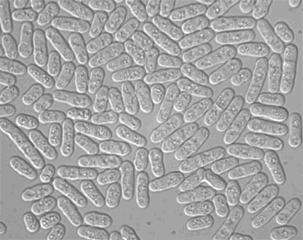Research
Yeast apoptosis
Programmed cell death (PCD) plays critical roles in a wide variety of physiological processes during embryogenesis and in the integrity and homeostasis of adult tissues (1-3). In most cases, physiological cell death occurs by a form of PCD called apoptosis. Apoptosis is coordinated by a complex network of regulators and effectors, which can be triggered by various toxins or external signals (e.g. ethanol, death-receptor ligands) and internal processes [e.g. mitotic catastrophe, DNA damage, replication failure, reactive oxygen species (ROS) (1;2;4)]. Apoptosis is characterized by distinct morphological and biochemical changes including DNA breakage, nuclear condensation and fragmentation, exposure of phosphatidylserine on the outer face of plasma membrane (1;2;5). In developed organisms, the role of apoptosis is protective by eliminating superfluous cells, cells that have been infected by pathogens, and cells that have suffered non-reparable DNA or other damages (6).
As extensive investigations in the last thirty years have clearly demonstrated, mitochondria play a central role in the execution of different apoptotic pathways (2;7;8). More recent studies have disclosed that the ER is also involved in the regulation of apoptosis both by sensitizing mitochondria to a variety of extrinsic and intrinsic death stimuli and by initiating cell-death signals of its own (9). ER stress is a cause of damaging apoptosis in numerous human pathologies including diabetes, obesity, neurodegenerative disorders, viral infection and a variety of ER storage diseases (9). Therefore, ER-mediated cell death programmes have received much attention (reviewed in (7)). Nevertheless, compared with our current knowledge on how mitochondria are involved in PCD, much remains to be learned about the ER-mediated signalling pathways of apoptosis (8).
The long-term objectives of our project are to understand the mechanisms of programmed cell death mediated by the endoplasmic reticulum (ER) and their implication on the physiology of the cell.
Our approach is to use of the genetic and biochemical power of S. pombe to deepen the current knowledge on the role of ER proteins in PCD. The use of a genetically tractable model such as S. pombe will assist in identifying core components of apoptotic pathways and in delineating their interactions within these death cascades. Our research will lead us to the formulation of hypotheses for ER-mediated apoptotic death that could be tested in mammalian cells. Ultimately, the outcome of our research should be of significance for the understanding and the eventual treatment of human pathologies due to enhanced or reduced activities of apoptotic pathways in the cell. Moreover, our studies on PCD in S. pombe should contribute to the development of pharmacological strategies against fungal pathogens such as Candida albicans.
References :
(1) Reed,
JC. 2000. Mechanisms of Apoptosis. Am J Pathol 157: 1415-30.
(2) Leist, M, Jäättelä, M. 2001. Four deaths and a funeral: from caspases to
alternative mechanisms. Nat.Rev.Mol.Cell.Biol. 2: 589-98.
(3) Kroemer,G, El-Deiry,WS, Golstein,P, Peter,ME, Vaux,D et al. 2005. Classification
of cell death: recommendations of the Nomenclature Committee on Cell Death. Cell
Death Differ 12: 1463-67.
(4) Jin,
C, Reed, JC. 2002. Yeast and apoptosis. Nat.Rev.Mol.Cell.Biol. 3: 453-59.
(5) Kerr, JFR. 2002. History of the events leading to the formulation of the
apoptosis concept. Toxicology 181-182: 471-74.
(6) Rodriguez-Menocal, L, D'Urso, G. 2004. Programmed cell death in fission yeast.
FEMS Yeast Research 5: 111-17.
(7) Szabadkai, G, Rizzuto, R. 2004. Participation of endoplasmic reticulum and
mitochondrial calcium handling in apoptosis: more than just neighborhood? FEBS
Letters 567: 111-15.
(8) Hauptmann, P, Riel, C, Kunz-Schughart, LA, Frölich, K-U, Madeo, F, Lehle, L.
2006. Defects in N-glycosylation induce apoptosis in yeast. Mol Microbiol 59:
765-78.
(9) Zhao, L, Ackerman,SL. 2006. Endoplasmic reticulum stress in health and
disease. Current Opinion in Cell Biology 18: 444-52.

